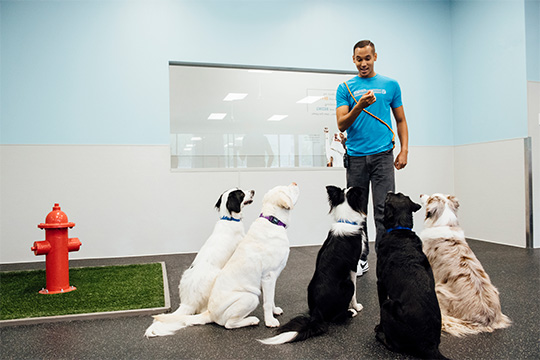Find the Best Dog Training Near Me for Effective Obedience and Behavioral Solutions
Find the Best Dog Training Near Me for Effective Obedience and Behavioral Solutions
Blog Article
Transform Your Dog's Habits With Proven Training Methods
Transforming your canine's habits needs a nuanced understanding of their specific characteristics and needs, in addition to the application of tested training techniques. By utilizing positive reinforcement and identifying vital add their body movement, you can properly deal with typical behavior problems such as extreme barking or jumping. Consistency in your training method not only enhances obedience but also fosters a deeper bond of count on and regard in between you and your pet. The course to effective improvement might offer unexpected obstacles that warrant more expedition.

Comprehending Canine Actions
Comprehending pet behavior is crucial for efficient training and communication in between people and their canine companions. Canines, as social pets, show a variety of habits affected by genetics, atmosphere, and experiences. Identifying these behaviors helps owners customize their training approaches to fulfill the specific requirements of their pet dogs.
Trick facets of pet behavior include body language, vocalizations, and social communications. Additionally, socialization plays an important role in shaping behavior; pet dogs that connect positively with different individuals and other pets are generally extra versatile and well-adjusted.
Additionally, acknowledging tension signals-- such as pacing, panting, or avoidance actions-- can stop acceleration right into a lot more severe problems. Proprietors who are attuned to their pet dog's behavior can develop a caring and risk-free environment, promoting count on and enhancing the training procedure. Ultimately, a deep understanding of canine actions lays the foundation for an unified relationship and reliable training results, guaranteeing both pets and their owners prosper together.
Positive Support Techniques
Favorable reinforcement methods are extensively acknowledged as one of one of the most reliable techniques for training dogs, promoting a favorable understanding atmosphere. This approach includes satisfying desired behaviors with treats, praise, or play, thus urging the dog to repeat those habits (Dog training). Unlike vindictive techniques, favorable reinforcement constructs trust fund and strengthens the bond between the instructor and the pet
Incentives need to be given promptly adhering to the preferred habits to help the canine make the connection. Uniformity is also important; making use of the very same commands and benefits helps the dog understand what is anticipated.
It is very important to note that favorable support is not regarding bribery; rather, it has to do with strengthening etiquette. In time, as the pet dog finds out to link certain actions with positive end results, the frequency of incentives can be slowly decreased, transitioning to verbal appreciation or recurring incentives. This technique not only encourages obedience yet likewise promotes a happy and certain pet, making training a much more satisfying experience for both events included.
Addressing Usual Issues
Dealing with typical problems during pet training is necessary for guaranteeing a successful and harmonious connection in between the pet and its owner. Lots of pet proprietors run into behavioral difficulties, such as too much barking, leaping, and leash pulling. Recognizing the root triggers of these actions is critical for effective training.
To minimize this, give enough physical exercise, psychological excitement, and opportunities for social communication with both humans and various other pet dogs. Training the pet to rest upon greeting can reroute this actions favorably.
Chain drawing is another prevalent issue, frequently arising from a pet dog's passion to discover. Making use of appropriate chain managing strategies, combined with training methods that urge loose-leash walking, can significantly boost this behavior.
Furthermore, problems like source safeguarding or splitting up stress and anxiety need customized strategies. Progressive desensitization and counter-conditioning can be efficient in addressing these difficulties. By acknowledging and proactively managing these common concerns, pet owners dog training near me can foster an extra enjoyable training experience and enhance the bond with their canine buddies.
Consistency in Training
Consistency is a keystone of reliable canine training, as it establishes a clear structure for the canine to recognize habits and expectations. When commands, cues, and rewards are used consistently, pet dogs can quicker realize what is called for of them. Inconsistent training can bring about confusion, causing unwanted actions that irritate both the fitness instructor and the pet.
To achieve consistency, it is crucial that all participants of the home abide by the very same training approaches. Using the very same spoken hints and hand signals guarantees that the dog gets consistent messages. In addition, the timing of benefits and modifications need to correspond; instant reinforcement boosts the chance that the canine will associate the behavior with the result.
Moreover, site developing a routine can even more improve uniformity. Normal practice, coupled with organized timetables for feeding, strolling, and play, help pets expect and recognize their setting, making them extra receptive to training. Ultimately, uniformity promotes a complacency and count on, empowering canines for more information efficiently. By dedicating to an organized strategy, fitness instructors can advertise favorable behavior changes and cultivate a courteous buddy.
Structure a Solid Bond
Exactly how can cultivating a strong bond between a pet dog and its proprietor improve the training experience? When a pet dog really feels safe in its connection with its proprietor, it is a lot more likely to show positive actions and be receptive to discovering.

Additionally, a well-established connection can reduce anxiety and behavior concerns, as pets are less most likely to act out when they really feel recognized and taken care of. As a result, prioritizing the development of a solid bond not just improves the training experience but also adds to a better and much more well-adjusted dog. Eventually, the journey of training changes into a collaborative collaboration, resulting in lasting behavior improvements.
Conclusion

Owners who are attuned to their canine's actions can develop a nurturing and risk-free atmosphere, cultivating trust fund and enhancing the training process. Eventually, a deep understanding of canine habits lays the structure for an unified partnership and reliable training end results, guaranteeing both pet dogs and their proprietors prosper with each other.
Resolving usual concerns throughout pet training is crucial for ensuring a unified and effective partnership in between the pet dog and its owner (Dog training).Consistency is a cornerstone of effective dog training, as it establishes a clear structure for the pet to recognize assumptions and behaviors.In verdict, changing a pet dog's Extra resources habits with shown training methods requires an understanding of canine behavior, the application of favorable support methods, and a focus on uniformity
Report this page